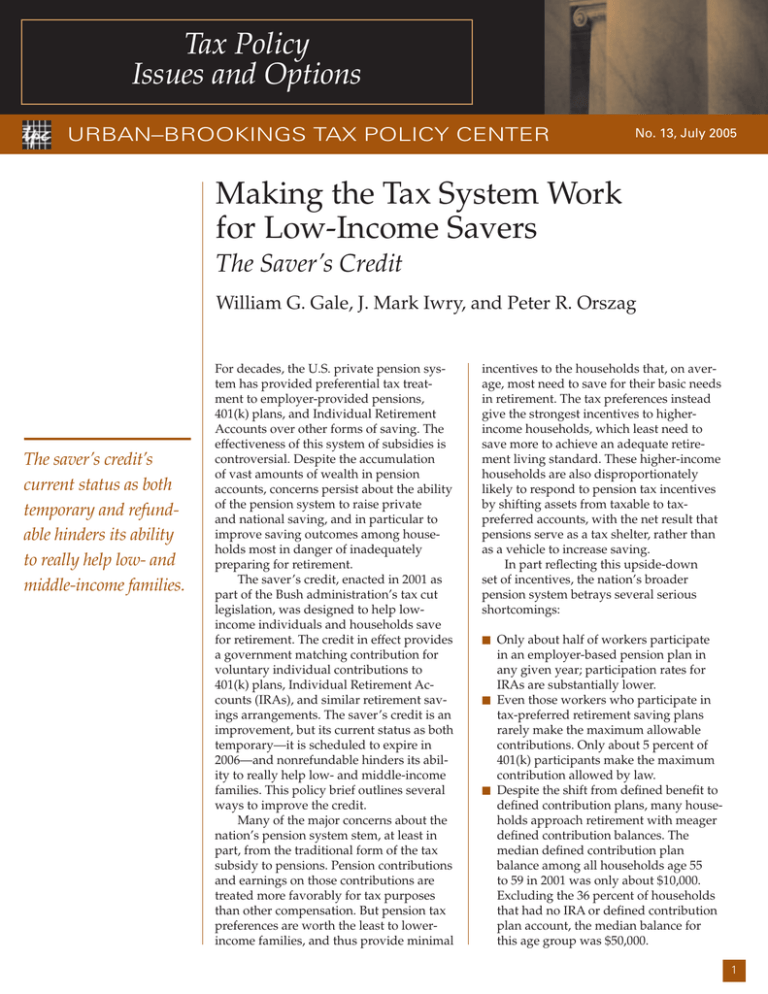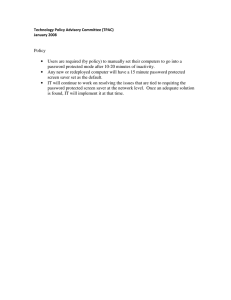Making the Tax System Work for Low-Income Savers The Saver’s Credit
advertisement

Tax Policy Issues and Options URBAN–BROOKINGS TAX POLICY CENTER No. No. 13, 13, July July 2005 2005 Making the Tax System Work for Low-Income Savers The Saver’s Credit William G. Gale, J. Mark Iwry, and Peter R. Orszag The saver’s credit’s current status as both temporary and refundable hinders its ability to really help low- and middle-income families. For decades, the U.S. private pension system has provided preferential tax treatment to employer-provided pensions, 401(k) plans, and Individual Retirement Accounts over other forms of saving. The effectiveness of this system of subsidies is controversial. Despite the accumulation of vast amounts of wealth in pension accounts, concerns persist about the ability of the pension system to raise private and national saving, and in particular to improve saving outcomes among households most in danger of inadequately preparing for retirement. The saver’s credit, enacted in 2001 as part of the Bush administration’s tax cut legislation, was designed to help lowincome individuals and households save for retirement. The credit in effect provides a government matching contribution for voluntary individual contributions to 401(k) plans, Individual Retirement Accounts (IRAs), and similar retirement savings arrangements. The saver’s credit is an improvement, but its current status as both temporary—it is scheduled to expire in 2006—and nonrefundable hinders its ability to really help low- and middle-income families. This policy brief outlines several ways to improve the credit. Many of the major concerns about the nation’s pension system stem, at least in part, from the traditional form of the tax subsidy to pensions. Pension contributions and earnings on those contributions are treated more favorably for tax purposes than other compensation. But pension tax preferences are worth the least to lowerincome families, and thus provide minimal incentives to the households that, on average, most need to save for their basic needs in retirement. The tax preferences instead give the strongest incentives to higherincome households, which least need to save more to achieve an adequate retirement living standard. These higher-income households are also disproportionately likely to respond to pension tax incentives by shifting assets from taxable to taxpreferred accounts, with the net result that pensions serve as a tax shelter, rather than as a vehicle to increase saving. In part reflecting this upside-down set of incentives, the nation’s broader pension system betrays several serious shortcomings: m m m Only about half of workers participate in an employer-based pension plan in any given year; participation rates for IRAs are substantially lower. Even those workers who participate in tax-preferred retirement saving plans rarely make the maximum allowable contributions. Only about 5 percent of 401(k) participants make the maximum contribution allowed by law. Despite the shift from defined benefit to defined contribution plans, many households approach retirement with meager defined contribution balances. The median defined contribution plan balance among all households age 55 to 59 in 2001 was only about $10,000. Excluding the 36 percent of households that had no IRA or defined contribution plan account, the median balance for this age group was $50,000. 1 Urban–Brookings Tax Policy Center ISSUES AND OPTIONS The saver’s credit is the first and only major federal legislation directly targeted to promoting tax-qualified retirement saving for moderate- and lower-income workers. The matching rates under the saver’s credit reflect a progressive structure—that is, the rate of government contributions per dollar of private contributions falls as household income rises, exactly the opposite of the incentive structure created by traditional pension tax preferences. This is currently a relatively minor exception to the general pattern: the bulk of recent policy changes have expanded retirement savings opportunities for higher-income workers, and the Treasury Department estimates that the tax expenditures associated with retirement saving preferences in 2005 total roughly $150 billion, of which only about $1 billion is attributable to the saver’s credit. Leading policymakers on the Ways and Means Committee, including Representatives Rob Portman (R-Ohio) and Benjamin Cardin (D-Md.), are actively exploring possible expansions of the saver’s credit. How the Saver’s Credit Works The saver’s credit applies to contributions of up to $2,000 per year per individual. As table 1 shows, the credit rate is 50 percent for married taxpayers with incomes up to $30,000. The credit rate then declines and is not available at all for those with incomes of $50,000 or above. (The same credit rates apply for others, too, with the income levels reduced by 50 percent for single filers, and by 25 percent for heads of households.) Without the saver’s credit, a $100 401(k) contribution by a taxpayer in the 35 percent marginal federal income tax bracket generates a $35 exclusion from income, resulting in a $65 after-tax cost to the taxpayer. In contrast, for a taxpayer in the 15 percent marginal bracket, the same $100 401(k) contribution generates only a $15 exclusion from income, resulting in a $85 after-tax cost. The tax deduction is worth more to the higher-income household. However, if the lower-income taxpayer qualifies for a 20 percent saver’s credit, the net after-tax cost is $65 ($100 minus the $15 effect of exclusion minus the $20 saver’s credit). Thus, the saver’s credit works to level the playing field by increasing the tax advantage of saving for moderate- and lower-income households. The implicit matching rate generated by the credit is significantly higher than the credit rate itself. The 50 percent credit rate for gross contributions, for example, is equivalent to having the government match after-tax contributions on a 100 percent basis. Consider an individual who contributes $2,000 to a 401(k) plan or IRA. The saver’s credit reduces federal income tax liability by $1,000 (50 percent of $2,000). The net result is a $2,000 account balance that costs the individual only $1,000 after taxes (the $2,000 contribution minus the $1,000 tax credit). This is the same result as occurs if the net after-tax contribution of $1,000 were matched at a 100 percent rate: the individual and the government each effectively contribute $1,000 to the account. Similarly, the 20 percent and 10 percent credit rates are equivalent to a 25 percent and 11 percent match, respectively. The saver’s credit was designed to support employer pension plans. In particular, the saver’s credit matches contributions to 401(k) and other plans by moderate- and lower-income employees. As a result, employees need not choose between the saver’s credit and an employer matching contribution in their 401(k). TABLE 1. Saver’s Credit for Married Couples Adjusted Gross Income Range for Joint filers Heads of households 0–$30,000 $30,001–$32,500 $32,501–$50,000 0–$22,500 $22,501–$24,375 $24,376–$37,500 Singles Credit rate Tax credit for $2,000 contribution After-tax cost incurred by individual to create $2,000 account balance Effective after-tax matching rate 0–$15,000 $15,001–$16,250 $16,251–$25,000 50% 20% 10% $1,000 $400 $200 $1,000 $1,600 $1,800 100% 25% 11% 2 Urban–Brookings Tax Policy Center ISSUES AND OPTIONS Box 1. The Saver’s Credit: An Example Ruth and Tom are married, file a joint return, and have $34,000 in income, all from Ruth’s salary. Ruth is eligible to participate in her employer’s 401(k) plan but has not done so in the past. Neither spouse has an IRA. After Ruth receives a notice about the saver’s credit from her employer, she and Tom decide that she will contribute $2,000 to the 401(k) and he will contribute $2,000 to an IRA. Their contributions reduce their adjusted gross income from $34,000 to $30,000, which means they qualify for the 50 percent credit rate under the saver’s credit. As a result, they receive a $2,000 tax credit (50 percent of $4,000). The couple begins to benefit from the saver’s credit early in the year when Ruth reduces the federal income tax withholding from her employer to reflect the fact that she and Tom will be entitled to the credit for the year. When the time comes to file their federal income tax return for the year, they claim the credit on their return. Ruth’s contribution also affects her employer’s 401(k) nondiscrimination test results. Ruth’s contribution has increased from 0 percent of pay (in previous years) to nearly 6 percent of pay ($2,000/$34,000), which increases the average 401(k) contribution percentage for the group of non-highly compensated employees eligible to participate in the plan. That increase, in turn, raises the permissible 401(k) contribution percentage for the highly compensated employees in the firm. IRS data indicate that more than 5 million tax filing units claimed the credit in 2002, the first year it was in effect. The credit is progressive: estimates from the Tax Policy Center suggest that almost 50 percent of the benefits accrues to filers with cash income between $10,000 and $30,000. And some early evidence suggests it may be raising saving: in one survey of plan sponsors in 2002, representatives of 71 percent of 401(k) plans in the survey indicated that they believed the saver’s credit had already increased participation in their plan’s 401(k). Tax preparer H&R Block, which has indicated that it claimed the credit in 2002 on behalf of more than a million clients, has found that many of those who claimed the credit were firsttime contributors to a retirement savings plan. Why the Saver’s Credit Makes Sense The saver’s credit focuses its incentives on lower- and moderate-income households. This makes sense for two reasons. First, such incentives are more likely to bolster long-term economic security and reduce poverty among the elderly, since higherincome households already tend to have substantial assets and to be better prepared for retirement than other households. For some low-income families, income may be so modest that it is impossible to save after paying for necessities. Yet according to a study by Jeanne Hogarth and Chris Anguelov (2001), 60 percent of households at or below the poverty level indicate that they save. Experience with a program that provides tax breaks and matching funds to encourage saving among participating low-income families suggests that poor families will save, at least to some degree, if presented with incentives to do so. Second, a key issue is the impact of tax incentives for saving on national saving. National saving is the sum of public saving and private saving. All else equal, every dollar of forgone revenue reduces public saving by one dollar. Consequently, for national saving to increase, private saving must increase by more than one dollar in response to each dollar in lost revenue. To raise private saving, the incentives must not simply prompt individuals to shift assets into tax-preferred pensions, but also generate additional contributions financed by reductions in spending. Since those with modest or low incomes are less likely to have other assets to shift into tax-preferred pensions, focusing pension tax preferences on moderateand lower-income workers increases the likelihood that lost tax revenue will reflect 3 Urban–Brookings Tax Policy Center additional contributions rather than shifts in assets. Empirical evidence suggests that tax-preferred retirement saving undertaken by lower-income workers is much more likely to represent new saving (rather than asset shifting) than tax-preferred retirement saving undertaken by higher-income workers. ISSUES AND OPTIONS Options for Reform Despite its relatively auspicious beginning and its solid policy justification, the saver’s credit has several important shortcomings that policymakers should address. First, the saver’s credit officially sunsets at the end of 2006. The cost of making the saver’s credit permanent, without any Box 2. A History of the Saver’s Credit The saver’s credit evolved from a series of efforts in the late 1990s to expand pension coverage among low- and moderate-income workers and distribute tax-preferred retirement benefits more evenly along the income scale. In 1999, President Clinton proposed Universal Savings Accounts (USAs). Instead of providing tax benefits based on an individual’s marginal income tax rate, these accounts included a matching contribution from the federal government, designed as a refundable tax credit, with the match rate falling as household income rose. In addition to matching voluntary contributions, the federal government would have provided automatic contributions to the accounts of workers with family incomes below a specified level, regardless of whether they made voluntary contributions. A key feature of USAs was the mechanism by which they were designed to integrate with employer plans. The USA government matching contributions were triggered by employee contributions to 401(k) and other employer plans (or by individuals’ contributions to USA accounts). This government match of employees’ contributions to 401(k)s— structured progressively to match lower-income individuals’ contributions at higher rates—survived to become, essentially, the saver’s credit. In 2000, the Clinton administration introduced Retirement Savings Accounts (RSAs), to address two concerns with the USA plan. To reduce the budgetary costs (roughly $30 billion a year), RSAs eliminated the automatic, nonmatching government contribution. To address concerns that the government contributions would be treated as a spending increase rather than a tax cut in the budget, RSAs provided that individuals would receive the matching contribution from the employer or the financial institution maintaining the account. The employer or financial institution, in turn, would receive income tax credits covering those contributions and administrative costs. Discussion of the RSA proposal raised concerns about the administrative functions employers would have to perform and the difficulty of using tax credits to reimburse employers or financial institutions that were nonprofits or that otherwise had no income tax liability. In addition, in the context of this proposal, the financial services industry sought to avoid a new separate individual account with tighter withdrawal restrictions and more limited investment options, pressing instead for a version of the proposal that would rely solely on existing forms of IRAs and 401(k) plans. In response to these discussions, and based on input from various private sector sources, the Treasury Department designed a refundable tax credit for low- and moderateincome savers in 2000. The proposal offered workers earning at least $5,000 a year with AGI of up to $75,000 (for married couples filing jointly) a refundable credit for their voluntary contributions to 401(k) and other employer plans and IRAs. Thus, the government matching deposit was transformed from a government deposit to an account to a tax credit that taxpayers would receive in the normal course of filing their income tax returns. Related proposals were introduced in Congress. A similar proposal gained the support of then-Senate Finance Committee Chairman Bill Roth (R-Del.), and Ranking Member Max Baucus (DMont.) backed a bill that was similar to the Clinton administration’s proposal. However, largely in order to meet their tight revenue targets for the pension package in which it was included—and to preserve revenue to pay for increased IRA and employer pension contribution limits and other elements of the overall pension package—this version of the proposal stripped out the refundable feature of the credit and drastically reduced the income eligibility limits and credit rate, while phasing the credit rate down through abrupt transitions from 50 percent to 20 percent to 10 percent to 0. This truncated provision was reported favorably by the Senate Finance Committee in September 2000, but was not taken up by the full Senate until 2001. The proposal was again reported favorably by the Senate Finance Committee in 2001, and was enacted as part of the pension provisions in the 2001 tax legislation. Unlike the other pension provisions in the 2001 act, which sunset at the end of 2010, the saver’s credit was enacted with a 2006 sunset. 4 Urban–Brookings Tax Policy Center ISSUES AND OPTIONS other changes, is between $1 and $2 billion a year. Second, the credit is currently not refundable. That means that millions of moderate-income households receive no incentive from it because they have no income tax liability against which to apply the credit. In particular, 58 million returns (77 million people) have incomes low enough to qualify for the 50 percent credit. Since the credit is nonrefundable, however, only about 16 percent of these returns could actually benefit from the credit if they contributed to an IRA or 401(k). Further, only 104,000—or roughly one of every 560—returns that qualify based on income could receive the maximum possible credit if they made the maximum eligible contribution. Refundability would add $3 billion a year to the cost of the credit. Refundability would make the full credit available to 49 million returns (65 million people) currently ineligible for any credit and to another 9 million returns (12 million people) eligible for a partial credit. Put differently, the “capacity” of the saver’s credit—which we define as the total amount of saver’s credit that could be made if everyone contributed the maximum amount—would rise from less than $14 billion under current law to $94 billion under refundability. Refundability could also positively affect firms’ willingness to offer pensions. Since the credit encourages low-income workers to contribute to 401(k)s, it tends to improve the average rate of contribution by nonhighly compensated employees who are eligible to participate in the 401(k), hence making it easier for firms to meet the 401(k) nondiscrimination standards. Note that the concerns typically raised about refundable credits are not applicable to making the saver’s credit refundable. In order to qualify for the saver’s credit, for example, an individual must make a contribution to a tax-preferred account, which is verified by third-party reporting (by the IRA trustee or plan administrator). In addition, to limit potential abuses, policymakers could require tax filers to have at least $5,000 in earnings per person in order to claim the refundable credit, which would modestly reduce the revenue cost. Finally, for families with somewhat higher incomes, the fact that the credit is not refundable poses much less of a problem. But for these families, the credit provides only a modest incentive for saving. For example, a married couple earning $45,000 a year receives only a $200 tax credit for depositing $2,000 into a retirement account. This small credit represents only a modest matching rate. To promote saving among middleincome households, the income eligibility for the 50 percent credit rate could be raised to $50,000 for married couples (and to singles with incomes of up to $25,000). According to the TPC model, median financial assets among those households that would benefit from the expanded 50 percent credit rate are currently about $30,000. Extending the 50 percent credit rate in this adds $5 billion a year to the cost of the credit. Additional expansions are possible, but each $10,000 increment above $50,000 for married couples adds another $4 billion a year in revenue cost. These changes could be paid for by repealing (or letting expire) the portion of the recent income tax cuts that pertains to high-income households and by selective reforms to the recently enacted changes to the estate tax. Conclusion The saver’s credit offers the potential to help correct the nation’s “upsidedown” tax incentives for retirement saving, in which the tax system provides the weakest incentives for participation in tax-preferred saving plans to those who most need to save for retirement and who are more likely to use tax-preferred vehicles to increase net saving than to serve as a shelter from tax. The limited experience with the saver’s credit has been encouraging, but among the options for improving the design of the credit are making it refundable, making it permanent, and expanding it to provide more powerful incentives for middle-class households. These changes would further help lower- and middleincome families save for retirement, reduce economic insecurity and poverty rates among the elderly, and raise national saving. Reference Hogarth, Jeanne M., and Chris E. Anguelov. 2001. “Can the Poor Save?” Proceedings of Association for Financial Counseling and Planning Education (2001). About the Authors William G. Gale is the Arjay and Frances Fearing Miller Chair in Federal Economic Policy in the Economic Studies Program at the Brookings Institution and codirector of the Tax Policy Center. J. Mark Iwry is a senior adviser at the Retirement Security Project and a nonresident senior fellow at the Brookings Institution. From 1995 to 2001, he served as the Benefits Tax Counsel of the U.S. Department of the Treasury. Peter R. Orszag is director of the Retirement Security Project, the Joseph A. Pechman Senior Fellow in Economic Studies at the Brookings Institution, and codirector of the Tax Policy Center. 5 THE URBAN INSTITUTE Nonprofit Org. U.S. Postage PAID Permit No. 8098 Ridgely, MD 2100 M Street, NW Washington, DC 20037 Address Service Requested To order additional copies of this publication, call 202-261-5687 or visit our online bookstore, http://www.uipress.org. THE BROOKINGS INSTITUTION 1775 Massachusetts Avenue, NW Washington, DC 20036 Phone: 202-797-6000 Fax: 202-797-6004 http://www.brookings.edu THE TAX POLICY CENTER The Tax Policy Center (TPC) aims to clarify and analyze the nation’s tax policy choices by providing timely and accessible facts, analyses, and commentary to policymakers, journalists, citizens, and researchers. TPC’s nationally recognized experts in tax, budget, and social policy carry out an integrated program of research and communication on four overarching issues: fair, simple, and efficient taxation; long-term implications of tax policy choices; social policy in the tax code; and state tax issues. A joint venture of the Urban Institute and the Brookings Institution, the TPC receives support from a generous consortium of funders, including the Annie E. Casey Foundation, Charles Stewart Mott Foundation, Cummings Foundation, Ford Foundation, George Gund Foundation, and Lumina Foundation for Education. The views expressed do not necessarily reflect those of the Urban Institute, the Brookings Institution, their boards of trustees, or their funders. http://www.taxpolicycenter.org THE URBAN INSTITUTE 2100 M Street, NW Washington, DC 20037 Permission is granted for reproduction of this document, with attribution to the Urban Institute. Copyright © 2005 Phone: 202-833-7200 Fax: 202-467-5775 http://www.urban.org The authors thank the John D. and Catherine T. MacArthur Foundation and the Pew Charitable Trusts for financial support. They also thank Matt Hall for outstanding research assistance.


